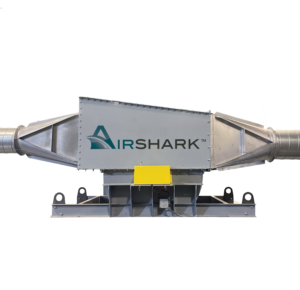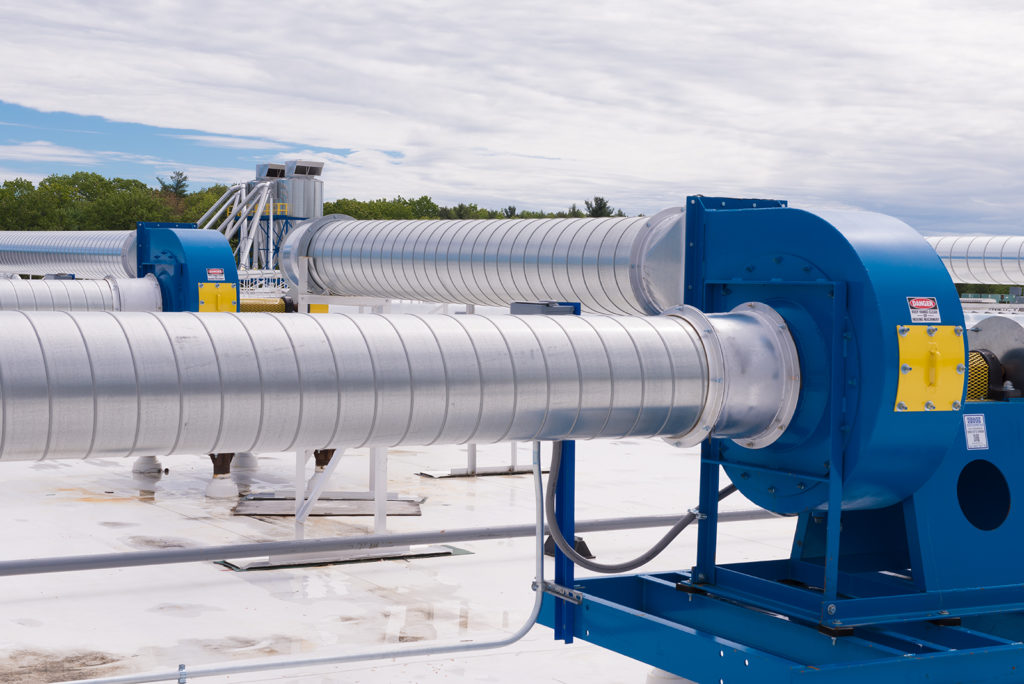Air Separation and Pneumatic Conveyance systems are finding a home in material recovery facilities.
By Jeff Dietterich
As published in Recycling Today magazine, April 2014
Material recovery facilities (MRFs) use automated equipment for much of their sorting and separating processes but have traditionally relied on a good deal of hand separation to achieve the highest rate of recovery with the lowest amount of contamination. However, that has begun to change as technological advances improve separation processes and as health and safety mandates demand better protections for workers.
Today’s MRF operators have more choices in how they move and separate their materials, and increasingly that choice involves using air.
A history of air conveyance
Air is among the most efficient means by which to separate materials and move them from one place to another. The laws of fluid dynamics and gravity combine to make air an ideal separation and transport medium for any number of materials. Consider the seed head of a dandelion; a light breeze is all it needs to disperse its seed and establish the next generation, much to the chagrin of lawn enthusiasts everywhere. Since ancient times, people have used the power of air to separate materials of different densities. Winnowing is the age-old process of separating chaff from grain by tossing it into the air, using wind to separate the lighter chaff from the heavier grain.
In one form or another, air separation has been in use from prehistory through the industrial revolution to today. The ability to separate materials based on their weight or density is why so many industries rely on air separation and pneumatic conveyance equipment for sorting, separation and processing.
The basic principles governing this process are being applied more commonly today in MRFs to separate and convey materials. Air separation and pneumatic conveyance can help to improve separation efficiency, increase automation, upgrade material quality and to create a cleaner and safer working environment. Equipment manufacturers have modified and adapted air separation equipment and systems from unrelated industries to work in the MRF environment.
It follows then that air separation and pneumatic conveying equipment and systems have been developed specifically for use in MRFs to separate lighter materials from heavier materials. Some of the benefits of these systems include reducing the manpower needed for hand sorting, increasing sorting system capacity, reducing equipment wear and tear associated with traditional mechanical separating systems and reducing personnel exposure to airborne contaminants.
Let’s take a look at some of these systems to get a better understanding of how they work and why they are growing in popularity in the recycling industry.
What are air separation systems?
Air separation systems are used to separate one type of material from another based on material density as well as on their aerodynamic properties. They are also used to segregate and capture material from the conveyance air stream for further processing or disposal. In both cases, the principle of terminal velocity is used to influence the target material to move in the desired direction.
 In the sixth edition of the McGraw-Hill Dictionary of Scientific & Technical Terms, terminal velocity in fluid mechanics is defined as “the velocity with which a body moves relative to a fluid when the resultant force acting on it (due to friction, gravity and so forth) is zero.” In the case of air separation systems, the fluid is air of a given density, and the forces are gravity and the pressure exerted by a moving air stream, expressed as cubic feet per minute, or CFM. By varying the pressure of a focused stream of air, you can overcome the force of gravity over a certain distance and achieve the desired separation of materials with different densities.
In the sixth edition of the McGraw-Hill Dictionary of Scientific & Technical Terms, terminal velocity in fluid mechanics is defined as “the velocity with which a body moves relative to a fluid when the resultant force acting on it (due to friction, gravity and so forth) is zero.” In the case of air separation systems, the fluid is air of a given density, and the forces are gravity and the pressure exerted by a moving air stream, expressed as cubic feet per minute, or CFM. By varying the pressure of a focused stream of air, you can overcome the force of gravity over a certain distance and achieve the desired separation of materials with different densities.
One common application of this principle is found in optical sorting equipment, where a burst of compressed air is used to separate one type of container from another, such as metal cans and plastic bottles. Another common use is a glass cleanup system, a secondary process whereby broken glass drops through a stream of upward moving air at sufficient velocity to remove the light fraction materials, such as paper and plastic labels, resulting in less contamination and increased value of the commodity.
Today, we are beginning to see more sophisticated air separation systems that have the ability to automatically separate materials of varying densities in two, three or four successive stages. While the separation efficiency is not nearly 100 percent and typically requires some hand sorting of the materials, the end result is a more productive and efficient way to separate high volumes of light fraction materials from the waste stream. This is even more important today with the influence of China’s Operation Green Fence policy, which requires cleaner bales of recyclables with fewer contaminants.
Even the residue at the end of the recovery process is getting one last pass through an air knife, which can be a more effective method of capturing small fiber and film than traditional fiber polishing screens. The idea is to remove and capture as much recoverable material as possible.
European manufacturers of air separation and pneumatic conveyance systems have lead the way into North American markets with equipment and systems that have been successfully used overseas for decades. The challenge for the domestic market is to justify the cost of these systems based on their ability to remove what are generally considered to be lower value materials from the stream of recyclables, thereby upgrading the value of the more desirable materials.
What are pneumatic conveyance systems?
Pneumatic conveyance systems use high-speed air to capture and transport materials from one point in the process to another, usually through overhead ducting. One advantage of these systems is their ability to move materials at a high rate of speed across great distances. The systems can be fed from various capture points along the process via drop chutes or capture hoods.
In MRFs this is often done as a series of pickups along a sorting conveyor, with personnel selecting the material to send up through the system. Sorters pull the desired material from the line and introduce it to the chute. The updraft of the suction line takes it away to another point for collection or further processing.
Most of us are familiar with aluminum can blowers, which are used to convey the cans from the eddy current separator to the storage bunker. One benefit of this type of conveyor over a traditional conveyor belt is that the materials travel through lightweight ducting over long distances, with very few moving parts to wear out, break down or maintain. Another benefit of pneumatic conveying is that it can “recycle” the conveyance air in a closed-loop system, so there is no loss of heated or conditioned air and no additional dust is introduced to the facility. We see this type of closed-loop design being employed in bag capture systems. These systems convey plastic bags and films from hand-sorting stations via a high-velocity airstream to an air/material separator, at which point they are dropped into a storage bunker, container or compaction unit.
Pneumatic conveyance systems also are being used to help clean the air within the MRF itself. All you need to do is look across the processing area of any automated MRF to see the haze caused by dust-laden air. In addition to being a lung and eye irritant for personnel, accumulated dust can become a potential fire and explosion hazard. Each rotating disc separator, ballistic separator and conveyor transfer point in an automated MRF is a potential generation point for airborne dust. In Europe, it is common for these types of mechanical separators and conveyor transfer points to be enclosed. The conveyance air is used to draw the dust-laden air away from the process and into a dust collector. While this has not been a common practice in North America, change is coming for air quality inside the modern MRF.
Air quality considerations
Recent changes to federal and state regulations, more stringent requirements from insurance companies and even local fire codes are bringing about changes in MRF design and operational procedures. For example, OSHA’s Combustible Dust Initiative is targeting all industries that produce combustible dust. Revised National Fire Protection Association (NFPA) standards focus on limits to the accumulation of dust on surfaces that under certain conditions can become airborne in such concentrations as to create an explosion in the presence of an ignition source.
These dust related problems can be addressed in many ways in new and existing facilities. Hand-sorting stations are being enclosed to provide better ventilation and climate control to improve workplace conditions. Facility design is evolving in ways that enclose or eliminate horizontal surfaces, such as exposed roof trusses and bar joists, that would naturally collect airborne dust as it settles. Even low-tech solutions like more frequent housekeeping can go a long way to reduce dust and improve air quality.
Going forward, MRFs of all types will see an increase in the use of air separation and pneumatic conveyance systems because of their efficiency and utility in an ever broadening range of applications. The integration of this technology in the modern MRF is a natural progression as processors look for new and better ways to enhance their operations and improve their bottom lines.
The author is president of Advanced Equipment Sales, Souderton, Pa., and can be contacted at aesjeff@aesales.net. For more information on Air Separation and Pneumatic Conveyance Systems, read all about the AirShark and other air conveyance systems here!


